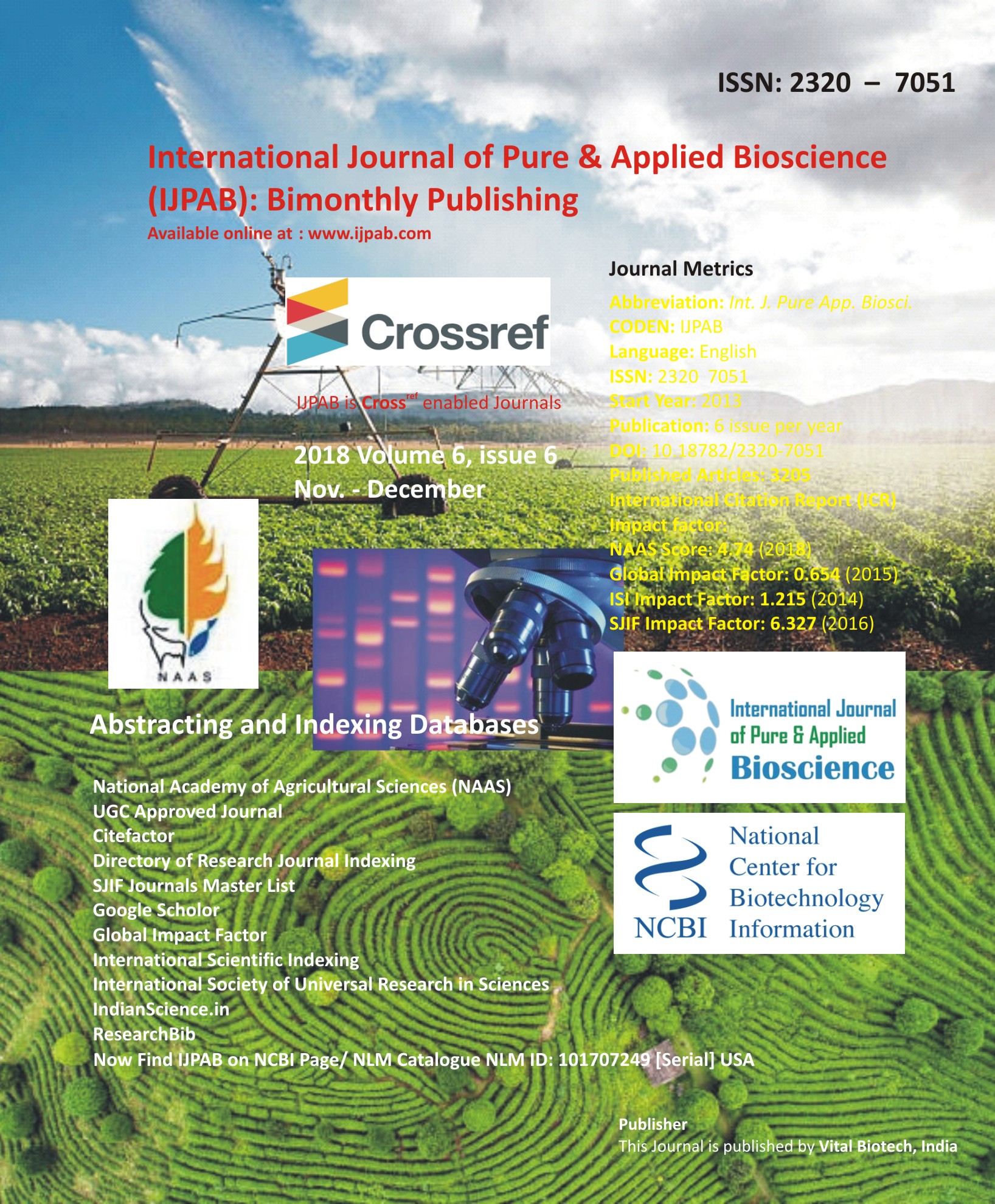
-
No. 772, Basant Vihar, Kota
Rajasthan-324009 India
-
Call Us On
+91 9784677044
-
Mail Us @
editor@ijpab.com
International Journal of Pure & Applied Bioscience (IJPAB)
Year : 2018, Volume : 6, Issue : 6
First page : (1039) Last page : (1041)
Article doi: : http://dx.doi.org/10.18782/2320-7051.7242
Evaluation of Different Integrated Nutrient Management Approaches for Sustainable Productivity of Finger Millet + Pigeonpea Cropping System under Rainfed Condition
Thimmegowda, M. N., Mudalagiriyappa, Puneetha, K. M., Savitha, M. S., Vasanthi, B. G., Devaraja, K. and Jayashree, H.T.
All India Coordinated Project for Dryland Agriculture, University of Agricultural Sciences, Gandhi Krishi Vignana Kendra, Bangalore-560065, Karnataka
*Corresponding Author E-mail: drylandgkvk@uasbangalore.edu.in
Received: 4.11.2018 | Revised: 19.12.2018 | Accepted: 24.12.2018
ABSTRACT
Experiment was conducted during kharif 2015-18 under rain-fed condition in Baichenahalli village of Tumakuru district under Operational Research Project (ORP) programme of AICRP for Dryland Agriculture, University of Agricultural Sciences, Bengaluru. Drylands are not only thirsty but also hungry, imbalanced nutrition is one of the major threat in achieving sustainable production under dryland condition, hence balanced nutrition is the practice to be advocated for the farmers. Demonstration was carried at farmer’s field to access the effect of different sources of nutrients on yield, RWUE and net returns. Two crops Finger millet (GPU 28) + Pigeonpea (BRG-2) with three treatments. T1: RDF (50:40:37.5 kg ha-1 NPK); T2: 50 % N through FYM + 50 % N and 100 % P, K through inorganic source + ZnSO4 (12.5 kg ha-1) + borax (10 kg ha-1) + bio fertilizer; T3: Farmers practice of only DAP and Urea (Finger millet + akkadi crops) were assessed. During 2015 and 2017, the rainfall received was above normal and erratic distribution caused marginal yield loss. Among different treatments T2 treatment resulted in higher finger millet equivalent yield of 4580 and 3659 kg ha-1 with net returns of Rs.77,965/- and Rs. 49000/- respectively. However, during 2016, low rainfall and erratic distribution hampered the crop almost to complete loss but among the different treatments supplementation of nutrients both through organic and inorganic sources (T2) resulted in better yield (1067 kg ha-1) compared to T1: RDF alone (963 kg ha-1) and T3: Farmers practice (578 kg ha-1). The average additional equivalent yield of 1061 kg ha-1 with 34.29 per cent increment was observed in (T2) treatment over Farmers practice (T3) of application of only DAP and urea. Irrespective of quantity and intensity of rainfall received, higher RWUE of 6.08 kg ha-mm-1 was observed in T2 treatment followed by T1 ( 567 kg ha-mm-1) treatment wherein only inorganic source of nutrient was applied. Thus integrated nutrient management with balanced application of nutrients helped in sustaining soil health and fertility.
Key words: Pigeonpea, Millet, Dryland, Cropping system
Full Text : PDF; Journal doi : http://dx.doi.org/10.18782
Cite this article: Thimmegowda, M.N., Mudalagiriyappa, Puneetha, K.M., Savitha, M.S., Vasanthi, B.G., Devaraja, K. and Jayashree, H.T., Evaluation of Different Integrated Nutrient Management Approaches for Sustainable Productivity of Finger Millet + Pigeonpea Cropping System under Rainfed Condition, Int. J. Pure App. Biosci.6(6): 1039-1041 (2018). doi: http://dx.doi.org/10.18782/2320-7051.7242

